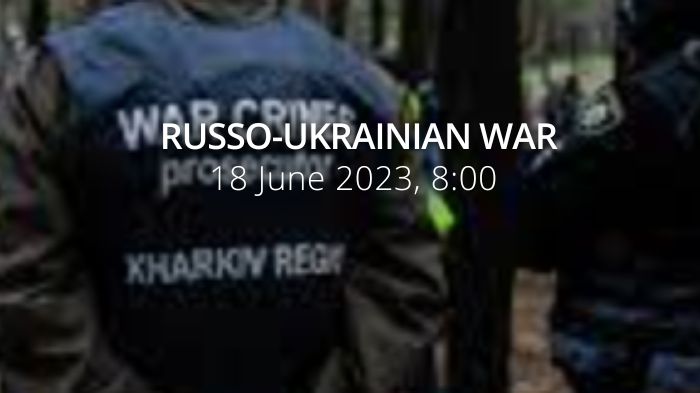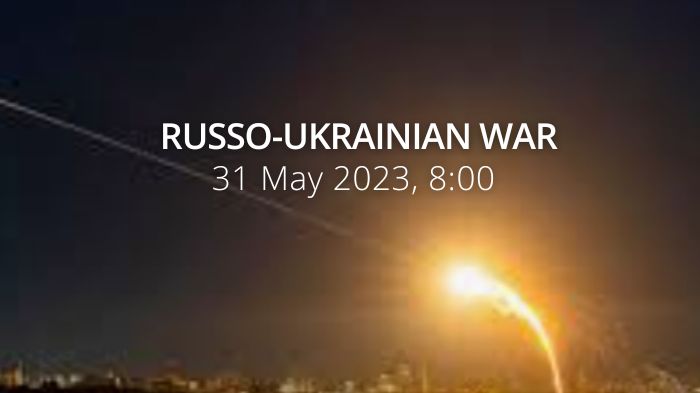Counteroffensive continues. Russia holds sham trial of 22 Azov Brigade members. UN experts raise ‘widespread’ torture concerns with Russia.
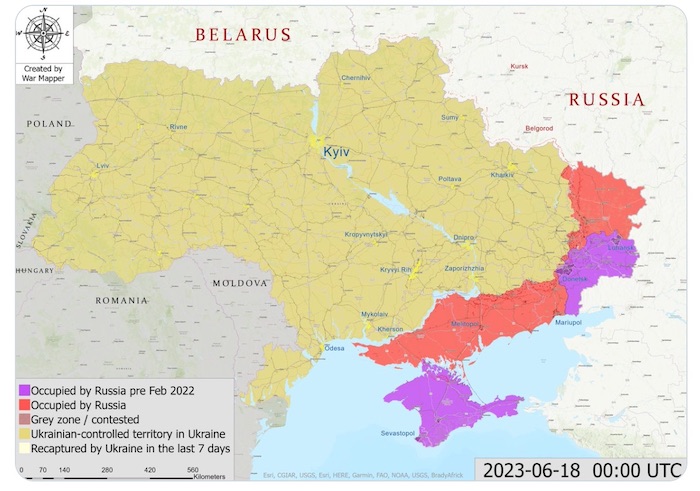
Daily overview — Summary report, June 18
The General Staff’s operational update regarding the Russian invasion as of 18.00 pm, June 18, 2023 is in the dropdown menu below:
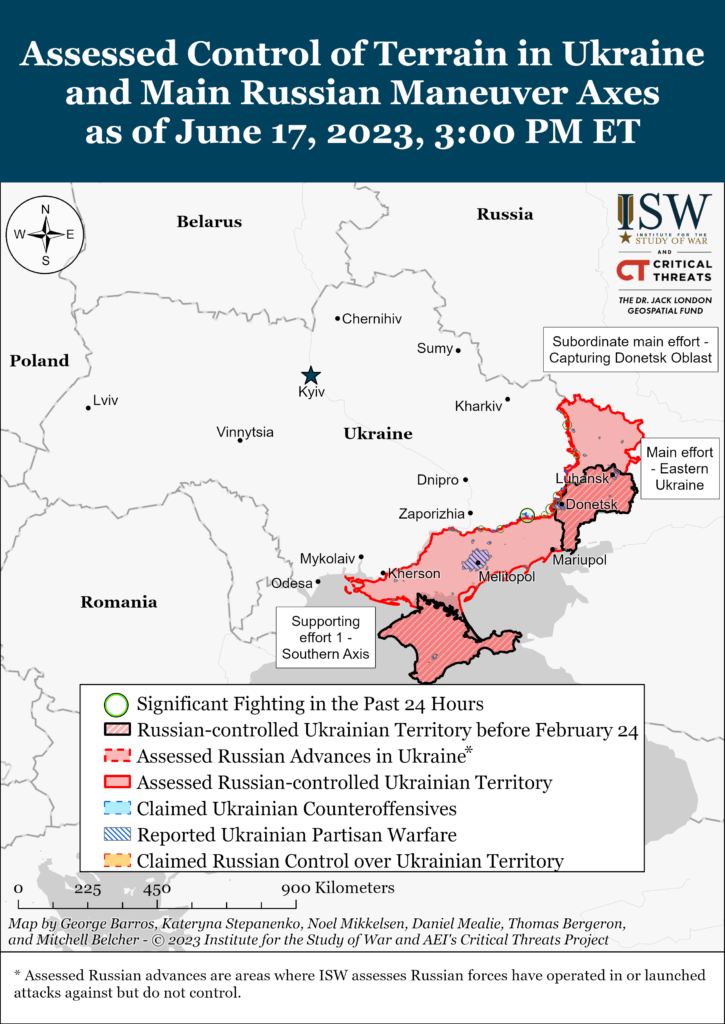
On June 17, the adversary launched 43 air and 4 missile strikes, 51 MLRS attacks at the positions of Ukrainian troops and various settlements.
The likelihood of missile and air strikes across Ukraine remains high.
The adversary focuses its main efforts on Lyman, Bakhmut, Avdiivka, and Marinka axes, with 26x combat engagements taking place On June 17.
- Volyn and Polissya axes: [the operational situation has not changed significantly. There are no signs of the formation of offensive groupings. On the training grounds of the Republic of Belarus, combat training and coordination of units of the Russian troops are underway after which they are sent to the frontlines on the territory of Ukraine.]
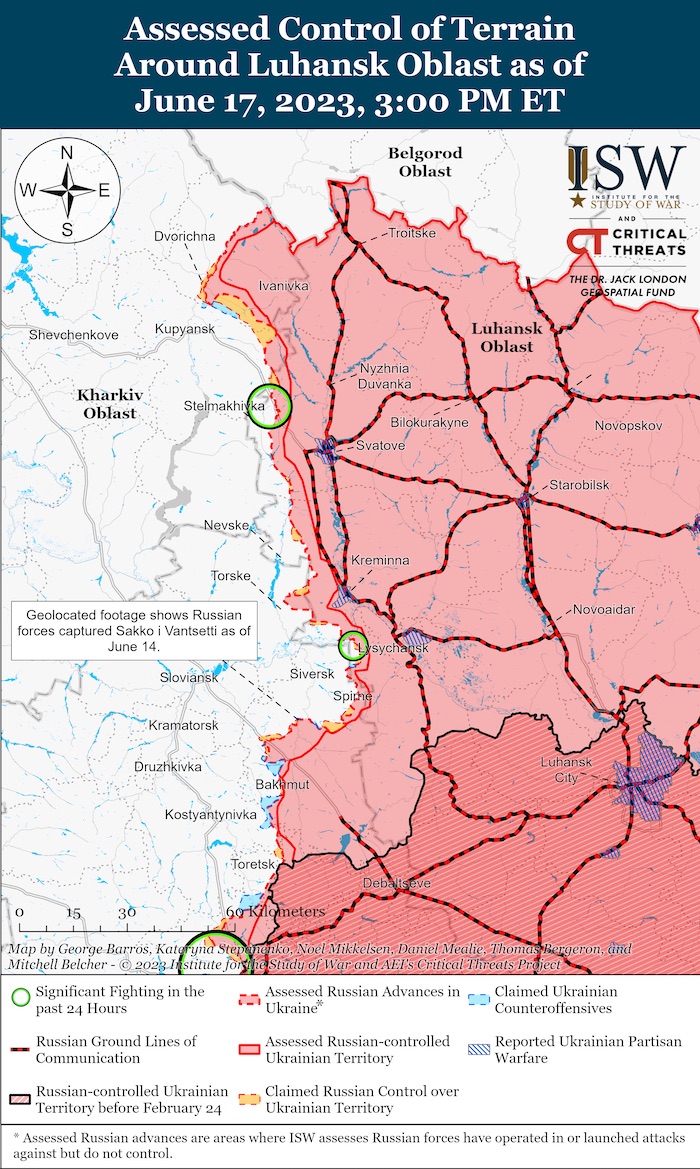
- Sivershchyna and Slobozhanshchyna axes: the adversary launched an airstrike on Yanzhulivka (Chernihiv oblast) on June 17. The invaders fired mortars and artillery at the settlements of Klyusy, Yanzhulivka, Kostobobriv, Halahanivka, Hrem’yach (Chernihiv oblast), Chuikivka, Bachivs’k, Svarkove, Atyns’ke, Starykove, Boyaro-Lezhachi, Stari Vyrky, Sosnivka, Iskryskivshchyna, Volfyne, Basivka, Myropillya, Stepok, Krasnopillya, Novodmytrivka, Velyka Pysarivka, Ponomarenky (Sumy oblast), Hur’yiv Kozachok, Udy, Chervona Zorya, Kozacha Lopan’, Strilecha, Starytsya, Ohirtseve, Pletenivka, Vovchans’ki Khutory, Pokalyane, Okhrimivka, Kruhle, Budarky, Zemlyanky, Loshakove, Potykhonove, and Komisarove (Kharkiv oblast).
- Kupiansk axis: the enemy attempted offensive operations towards Novoselivs’ke (Luhansk oblast) and Berestove (Kharkiv oblast), to no success. The adversary fired artillery and mortars at Fyholivka, Dvorichna, Zapadne, Kam’yanka, Kyslivka (Kharkiv oblast), and Novoselivs’ke (Luhansk).
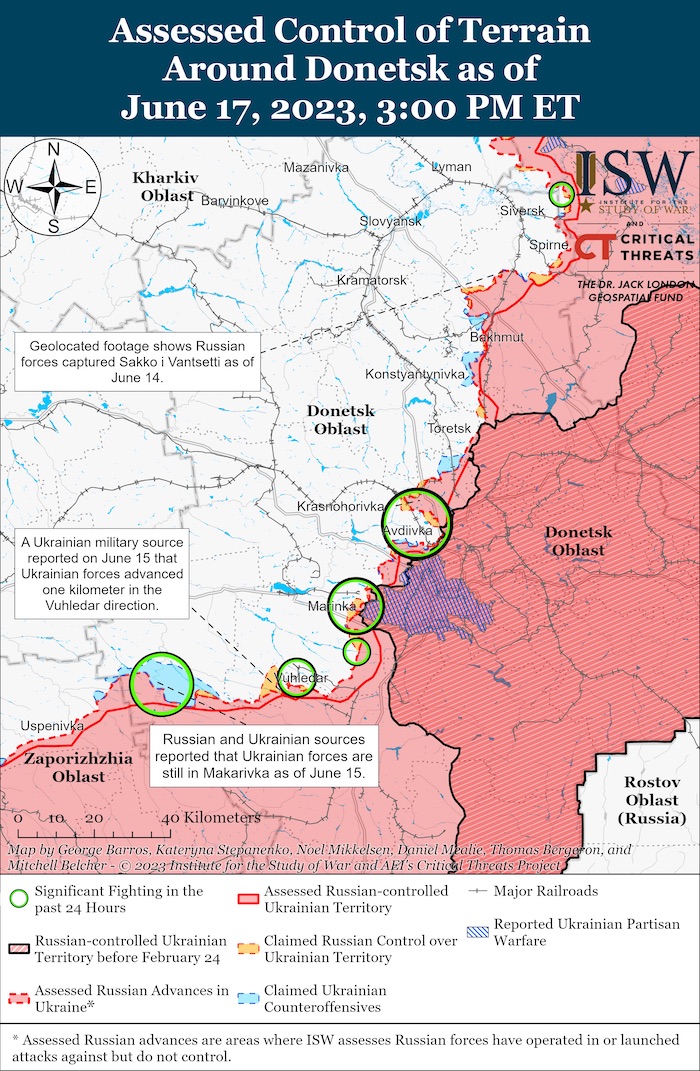
- Lyman axis: the enemy conducted offensive operations towards Bilohorivka (Luhansk oblast), to no success. Stel’makhivka, Nevs’ke, Bilohorivka (Luhansk oblast), Tors’ke, Verkhn’okam’yans’ke, Rozdolivka, Spirne, and Serebryanka (Donetsk oblast) were shelled with artillery.
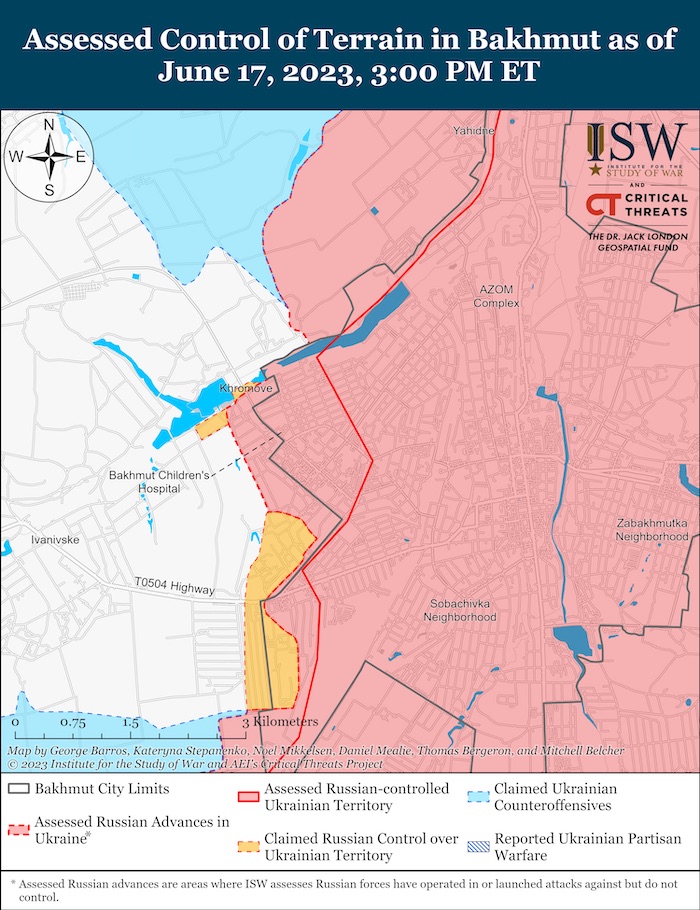
- Bakhmut axis: the vicinities of Orikhovo-Vasylivka, Bohdanivka, Khromove, Chasiv Yar, Ivanivske, Ozarianivka, Bila Hora, Kostyantynivka, and Pivdenne (Donetsk oblast) suffered from enemy artillery shelling.
- Avdiivka axis: the adversary conducted unsuccessful offensives in the vicinity of Stepove and Avdiivka, and launched airstrikes in the vicinities of Sukha Balka and Avdiivka. The invaders fired artillery at the settlements of Stepove, Tonen’ke, Pervomais’ke, Avdiivka, Vesele, and Karlivka (Donetsk oblast).
- Marinka axis: Ukrainian defenders repelled all enemy attacks in the vicinity of the city of Marinka. The enemy launched an airstrike in the vicinity of Krasnohorivka (Donetsk oblast). At the same time, the invaders fired artillery in the vicinities of the settlements of Krasnohorivka, Heorhiivka, Mar’inka, Pobjeda, Maksymil’yanivka, and Kostyantynivka (Donetsk oblast).
- Shakhtarske axis: the enemy attempted offensive operations towards Novomykhailivka and Vodyane (Donetsk oblast), to no success. Russian forces launched airstrikes near Zolota Nyva, Blahodatne, and Vuhledar. The invaders shelled the settlements of Shakhtars’ke, Prechystivka, Novomykhailivka, Vuhledar, Storozheve, Novosilka, and Novopil’ (Donetsk oblast).
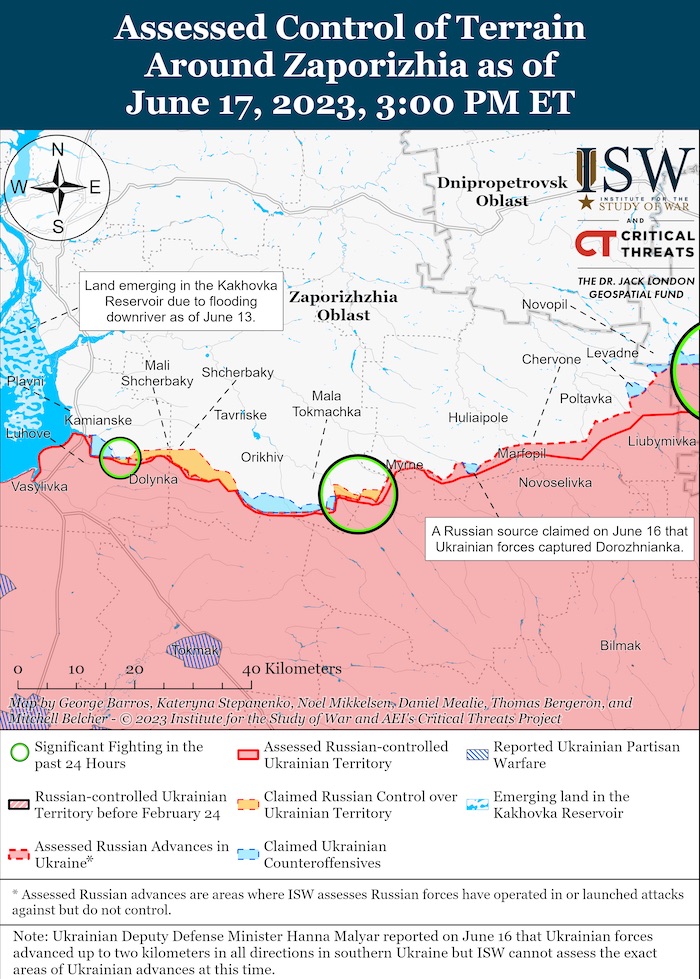
- Zaporizhzhia and Kherson axes: the adversary stays on the defensive. The enemy launched an air strike in the vicinity of Mala Tokmachka (Zaporizhzhia oblast), Havrylivka, Kozats’ke, and Komyshany (Kherson oblast). The invaders fired artillery at the settlements of Ol’hivs’ke, Hulyaipole, Zaliznychne, Huliaipilske, Novodarivka, Levadne, Malynivka, Chervone, Novoandriivka, Stepove, Lobkove, Stepnohirs’k, Kam’yans’ke (Zaporizhzhia oblast), Nikopol’ (Dnipropetrovsk oblast), Mykhailivka, Novodmytrivka, Chervonyi Mayak, Shlyakhove, Beryslav, Vesele, Kozats’ke, Mykolaivka, Burhunka, Ol’hivka, Tyahynka, Novotyahynka, Ponyativka, Sadove, Molodizhne, Antonivka, Kherson, Chornobaivka, Romashkove, Dniprovs’ke, Berehove, Veletens’ke, Kizomys, Sofiivka (Kherson oblast), and Ochakiv (Mykolaiv oblast).
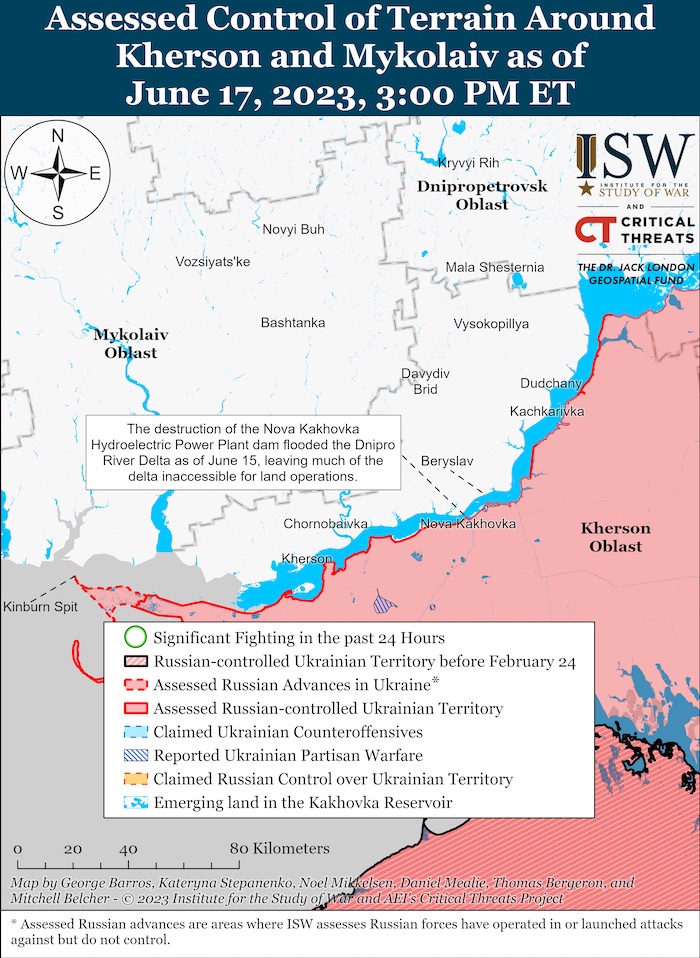
Russian deserters are fleeing the frontline in the temporarily occupied territories of Luhansk oblast. A group of Russian deserters from among the mobilized were reported being searched in the forest plantations near the settlement of Novorozsosh. Rosgvardia (Russian national guard) units are involved in the search.
[The Russian occupiers continue to commit ecocide on the Dzharylgach island, where they have set up a training ground and conduct military training for the mobilized, in particular, with the firing of artillery units.]
On June 17, the Ukrainian Air Force launched 14 air strikes on the concentrations of the adversary troops. Also, the Ukrainian defenders destroyed 2 anti-aircraft missile systems.
On June 17, the Ukrainian missile and artillery troops hit 3 command posts, 2 concentrations of troops, 5 ammunition depots, and 3 artillery units at their firing positions.
Military Updates
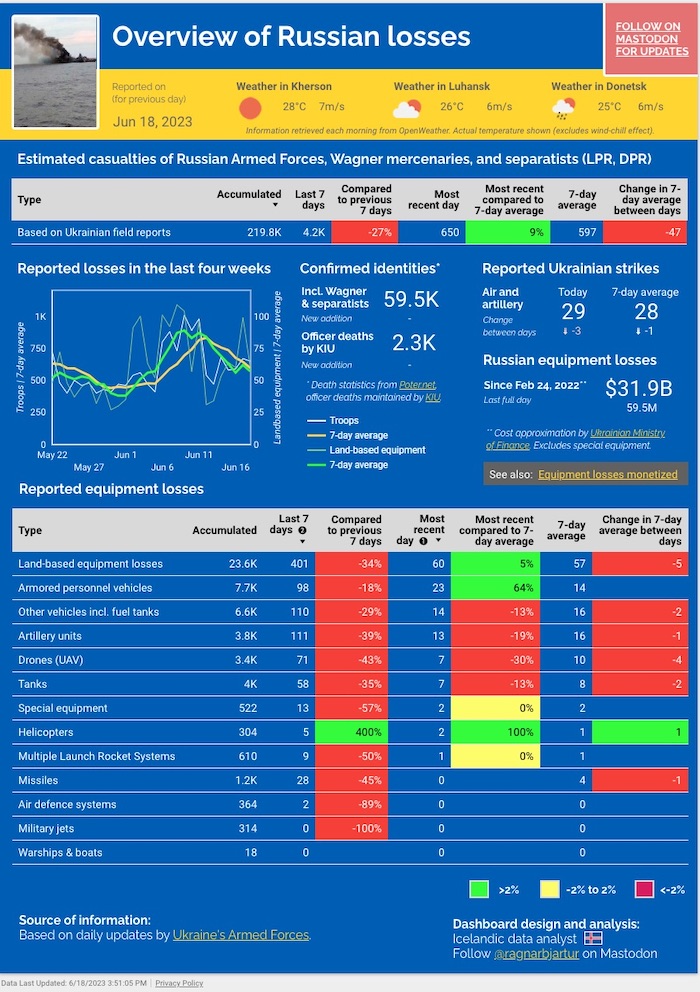
Russians attack Odesa and Mykolaiv Oblasts with Shahed drones, Ukrainska Pravda reports, citing the Ukrainian Air Force. “On the night of 15-16 June, Odesa and Mykolaiv Oblasts were attacked by Iranian Shahed drones, Ukrainian air defence is engaged.”
Ukrainian forces make gains near Vuhledar – Commander of Tavriia Group of Forces, Ukrainska Pravda reports. “Brigadier General Oleksandr Tarnavskyi, Commander of the Tavriia Operational and Strategic Group of Forces, has said that Ukrainian forces are making gains on the Vuhledar front in eastern Ukraine.»
In some areas, Russia’s manpower losses up to nine times greater than Ukraine’s, Ukrinform reports, citing Deputy Minister of Defense Hanna Maliar. “Russian propaganda has been producing absolutely fake news about Ukraine’s military losses for the past week and a half because in some areas of the front, the enemy’s losses in manpower are six to nine times greater than those on the Ukrainian side.
During the past week and a half, we have noticed an intensification of Russian propaganda efforts along the lines of two narratives. They are trying to circulate reports about seemingly huge losses on the Ukrainian side and discredit Western aid. In fact, according to military calculations, the Russians in some areas of the front line suffered losses that are six to nine times larger than Ukraine’s. That’s why these fake news are easy to refute,” Maliar said.
According to her, the enemy seeks to sow panic among the Ukrainian military with such fake reports of losses, disrupt mobilization processes and, on the contrary, encourage their own. But our losses are disproportionately lower than the enemy’s, said the deputy minister.
As for another fake about military aid to Ukraine, Maliar believes that the enemy’s task is to discredit Western weapons, but they also fail to do so. We do not hide the fact that there are losses, but our losses are much smaller than the Russian ones. We destroy much more of their equipment and weapons, and, secondly, we have already demonstrated that the equipment provided by Western partners performs a variety of different tasks and allows us to preserve the lives of our military personnel as much as possible. And it is with the help of this equipment that we liberate our territories. Therefore, none of these media efforts live long in the information field, she emphasized.”
According to British Defence Intelligence, (last 48 hours):
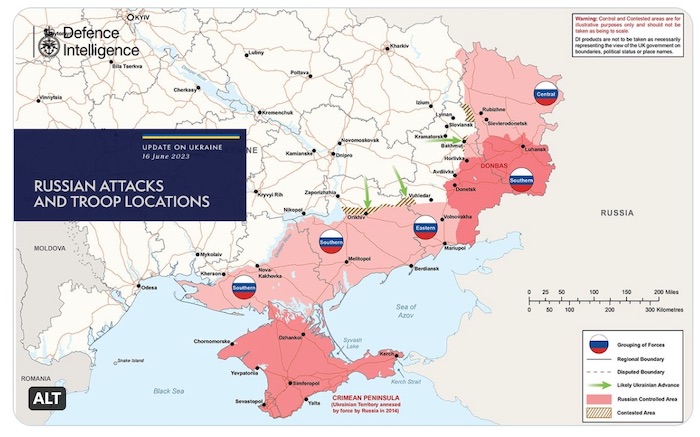
- General-Major Sergei Goryachev was almost certainly killed in a strike on a command post on or around 12 June 2023, in southern Ukraine.
- Goryachev was the chief of staff of 35th Combined Arms Army (35 CAA). With 35 CAA’s nominated commander, General-Lieutenant Alexandr Sanchik, reported to be filling a gap in a higher HQ, there is a realistic possibility that Goryachev was the acting army commander at the time of his death.
- Goryachev is the first Russian general confirmed killed in Ukraine since the start of 2023.
- It continues a war record which has been both difficult and controversial for 35th CAA: in March 2022 elements of the army were present during the massacre of civilians in Bucha, and in June 2022 the force was largely wiped out near Izium.
- On 10 June 2023, the Russian MoD demanded that members of ‘volunteers formations’ such as Wagner Group sign contracts directly with the MoD, a move explicitly endorsed by President Putin on TV on 13 June 2023.
- For several months, Wagner owner Yevgeny Prigozhin has been aiming vitriolic criticism at the MoD hierarchy but deferred to Putin’s authority.
- However, despite Putin’s comments, on 14 June 2023 Prigozhin said that, ‘none of Wagner’s fighters are ready to go down the path of shame again. That’s why they will not sign the contracts’. Prigozhin’s rhetoric is evolving into defiance of broader sections of the Russian establishment. 01 July 2023, the deadline for the volunteers to sign contracts, is likely to be a key way-point in the feud.
Losses of the Russian army
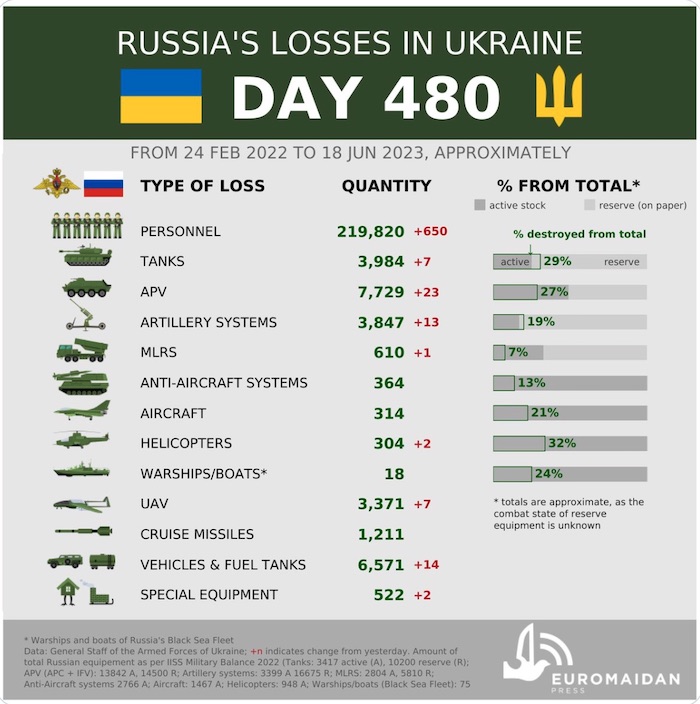
As of Friday 16 June, the approximate losses of weapons and military equipment of the Russian Armed Forces from the beginning of the invasion to the present day:
- Personnel – about 218500 (+590)
- Tanks – 3965 (+10)
- Armoured combat vehicles – 7683 (+16)
- Artillery systems – 3812 (+19)
- Multiple rocket launchers –MLRS – 606 (+2)
- Air defence means – 364 (+0)
- Aircraft – 314 (+0)
- Helicopters – 301 (+0)
- Automotive technology and fuel tanks – 6519 (+13)
- Vessels/boats – 18 (+0)
- UAV operational and tactical level – 3357 (+24)
- Special equipment – 519 (+0)
- Mobile SRBM system – 4 (+0)
- Cruise missiles – 1199 (+0)
Special Operations Forces destroy Russian Zoopark radar system and electronic warfare station with HIMARS, Ukrainska Pravda reports, citing the press service of the Special Operations Forces. “Operators of one of the Special Operations Forces units have destroyed two systems belonging to the Russians in the area of Bakhmut by using HIMARS.
It is noted that the Special Forces soldiers reconnoitred the positions of the ZOOPARK-1 artillery reconnaissance radar system and the Borisoglebsk-2 electronic warfare station.”
Russia dismisses Storm-Z unit: Convicts turned out to be inefficient, Ukrainska Pravda reports, citing the press service of the Defense Intelligence of Ukraine. “The Russian military leadership is regrouping the remnants of convicts from the so-called Storm-Z companies, which have low combat capability. In practice, the occupation units [Storm-Z companies – ed.], equipped with the so-called ‘special contingent’, showed extremely low combat capability.
Alcoholism, looting, and desertion flourish among the invading convicts, including through catastrophic losses. According to the Main Directorate of Intelligence of the Ministry of Defence of Ukraine, Russia is transferring the remaining convicts from the so-called Storm-Z companies to replenish the Volunteer Corps.”
Humanitarian
653 batches of military humanitarian aid disappear in Ukraine, Ukrainska Pravda reports, citing the State Customs Service of Ukraine. “Since the beginning of 2023, the State Customs Service has detected 653 cases of missing goods that passed through customs as humanitarian aid to the military. The disappearance of the cargo was discovered during joint inspections by the State Customs Service and the Ministry of Defence to ensure that military units and enlistment offices received the goods that were transported across the customs border to them as humanitarian aid.
During January-May 2023, 653 cases of non-confirmation of receipt of such goods as plates for body armour, night vision devices, thermal imagers, drones, vehicles, etc. were identified. In total, more than 5,000 cases of humanitarian aid being shipped to about 100 military units were checked.
The State Customs Service has also stated that the mechanism of humanitarian aid to the military is increasingly being abused. For five months of 2023, the State Customs Service drew up 115 protocols on violations of customs rules, where the subjects of offences were goods imported into the customs territory of Ukraine as humanitarian aid. For comparison, throughout 2022, the customs offices of the State Customs Service drew up 100 similar protocols on violations of customs rules.”
Thirty-seven settlements remain flooded after Ukraine dam breach, Ukrinform reports, citing Ukrainian Interior Minister Ihor Klymenko. “Thirty-seven towns and villages remain flooded after Russia’s destruction of the dam of the Kakhovka Hydroelectric Power Plant, including 20 in Ukrainian-controlled areas. These are more than 1,800 houses, Klymenko said.”
Environmental
IAEA Director General speaks of what he saw at Zaporizhzhia Nuclear Power Plant, Ukrainska Pravda reports, citing Rafael Grossi’s post on Twitter. “After his visit to the Zaporizhzhia Nuclear Power Plant (ZNPP), Rafael Grossi, Director General of the International Atomic Energy Agency (IAEA), stressed the utmost need for maintaining the required levels of water in the pond that are essential for cooling the nuclear station; especially critical after the destruction of the Kakhovka Dam.
On 15 June, the IAEA Director General visited the temporarily occupied Zaporizhzhia NPP for the third time. After the visit, Grossi noted that one of the key consequences of the destruction of the dam of the Kakhovka Hydroelectric Power Plant is a decrease in the water level in the cooling pond of the ZNPP, which is essential for the plant’s safety. Currently, the water level is remaining at a sufficient level to ensure that the station can maintain safety “for a certain period of time,” he said.
Grossi added this will be monitored by IAEA very carefully. […] He noted that he had collected enough data and the IAEA would monitor the situation further.”
Russia likely preparing for cold shutdown of Unit No. 5 at Zaporizhzhia Nuclear Power Plant, Ukrainska Pravda reports, citing Petro Kotin, Head of Energoatom. “Energoatom, the Ukrainian national nuclear energy generating company, has evidence that Russia is preparing for a cold shutdown of Unit No. 5 at the Zaporizhzhia Nuclear Power Plant (ZNPP), which is considered to be the safest mode for a nuclear reactor.”
It’ll take 3-5 years to restore irrigation systems – SFU, Ukrinform reports, citing Taras Kot, first deputy head of the State Agency of Land Reclamation and Fisheries of Ukraine (SFU). “Under favourable conditions (end of Russia’s war, sufficient financial resources, materials, equipment, machinery, etc., sufficient volumes of Dnipro runoff to fill the reservoir with water), the restoration of these reclamation systems (in Kherson, Dnipro, and Zaporizhzhia regions – ed.) can be completed in at least 3-5 years, he said. Kot noted that the destruction of the Kakhovka HPP left 94% of irrigation systems in Kherson, 74% in Zaporizhzhia, and 30% in Dnipro regions without a source of irrigation for a long time. In total, more than 350 irrigation pumping stations and about 1,100 kilometres of reclamation canals cannot be used.
According to him, when irrigation systems do not function for a long time, they are not only destroyed but also stolen, starting with metal elements, and ending with concrete slabs of canals, especially in the occupied territories. Similarly, on-farm reclamation systems and farmers’ sprinkler equipment will be stolen. The initial value of the state property of reclamation systems and canals that were tied to the Kakhovka reservoir is over UAH 2 billion, which in terms of current prices is UAH 150-160 billion. This is the estimated cost of restoring the reclamation infrastructure. These figures can be clarified only after the de-occupation of the territories, Kot stated.
SFU’s deputy head reminded that in the last pre-war years, 31 irrigation systems on about 584,000 hectares (of which 512,000 hectares are now in the occupied territories) were fed from the Kakhovka reservoir. These include 329,400 hectares in Kherson region, 204,300 hectares in Zaporizhzhia region, and 50,200 hectares in Dnipro region. The largest of these systems (both in Europe and the world), the Kakhovka irrigation system, supplied water to over 250,000 hectares.
Out of 584,000 hectares supplied with water for irrigation purposes from the Kakhovka reservoir in the pre-war years, the Kakhovka main canal served 326,000 hectares, the North Crimean Canal, 39,700 hectares. A number of systems in Zaporizhzhia, Kherson, and Dnipro regions carried out their own separate water intake from the reservoir for a total irrigation area of 218,300 hectares. The largest of them are Pivnichno-Rohachynska, Zaporizhzhia, Ivanivka, Nikopol, and Vyshchetarasivka irrigation systems.”
Legal
Russia holds sham trial of 22 Azov Brigade members, Ukrainska Pravda reports, citing Associated Press (AP). “The Russian city of Rostov-on-Don has hosted a show trial of 22 Azov Brigade members who defended the city of Mariupol and Azovstal steelworks; eight of the defendants are women who reportedly worked as cooks. These are members of the Azov Brigade who fought Russian invaders in Mariupol.
Russian authorities have recognised Azov as a terrorist organisation. Russia has charged Ukrainian soldiers with “participation in a terrorist organisation” and actions aimed at overthrowing the Russian-backed government in Donetsk Oblast.
Should they be found “guilty”, the Russians may sentence the Ukrainian fighters for a prison mterm from 15 years to life-long sentence. Russia transferred two of the 24 people facing charges to Ukraine in exchange for Russian prisoners of war during a recent prisoner swap. Among the remaining 22 Azov soldiers, eight were reported to be women who worked as cooks.”
UN experts raise ‘widespread’ torture concerns with Russia, Reuters reports. “A group of UN experts said on Thursday they had written to Moscow raising concerns about the use of torture by Russian military forces on Ukrainian civilians and prisoners of war. The UN experts said in a statement the torture included electric shocks, hoodings and mock executions and had been carried out to extract intelligence, force confessions or in response to alleged support for Ukraine’s forces. It had resulted in damage to internal organs, cracked bones and fractures, strokes and psychological traumas, they said.
A spokesperson for Russia’s diplomatic mission in Geneva did not immediately respond to a request for comment. […] While torture allegations have previously been levelled against both sides in the 15-month conflict, the team of UN independent experts said Russian forces’ methods may be “state-endorsed”.
The consistency and methods of alleged torture suggested “a level of coordination, planning and organisation, as well as the direct authorisation, deliberate policy or official tolerance from superior authorities”, according to UN Special Rapporteur on Torture Alice Jill Edwards, who sent the letter on 12 June alongside several other independent experts.”
US Congress proposes to allow confiscation of Russian Central Bank assets in favour of Ukraine, Ukrainska Pravda reports. “On Thursday 15 June, a bipartisan group of US senators introduced a draft act on the Rebuilding Economic Prosperity and Opportunity for Ukrainians Act (REPO), which significantly expands the possibility of confiscation of Russian assets and their transfer in favour of Ukraine. This was announced by the United States Senate Committee on Foreign Relations, members of which prepared the initiative, reports European Pravda
The bill provides for additional assistance to Ukraine at the expense of assets confiscated from the Central Bank of the Russian Federation and other sovereign assets of Russia. If passed, the document would, among other things, give the president the authority to confiscate Russian sovereign assets that have been frozen in the US and hand them over to help rebuild Ukraine.
In addition, sanctioned Russian companies will not be able to profit from assets until Russia withdraws from Ukraine and agrees to provide compensation for harm caused by its unprovoked war. The REPO also provides for increased coordination between the United States and allies for the similar confiscation of Russian sovereign assets in other countries and ensures Putin – not US taxpayers – foots the bill for the damage caused by Russia’s unprovoked invasion of Ukraine.
A similar initiative was filed by representatives of the Democratic and Republican parties in the US House of Representatives.”
Support
Ukraine war aid: Austin asks US allies to ‘dig deep’, Reuters reports. “Ukraine has begun their attack and they are making steady progress. This is a very difficult fight. It’s a very violent fight, and it will likely take a considerable amount of time at a high cost, Army General Mark Milley, chairman of the Joint Chiefs of Staff, said at NATO headquarters in Brussels. Milley was speaking after a meeting of the US-led Contact Group of some 50 countries that give military aid to Ukraine.
US Defense Secretary Lloyd Austin told the meeting that Kyiv needed both short-term and long-term support as the war was a “marathon, not a sprint”. Austin noted the group had already given Patriot, IRIS-T and NASAMS air defence systems that had protected Ukraine from Russian missile attacks. But he said Ukraine needed even more.
I ask that the members of this Contact Group continue to dig deep to provide Ukraine with the air defence assets and munitions that it so urgently needs to protect its citizens, Austin said in opening remarks. We’ll also continue to adapt our assistance to meet the changing circumstances on the ground in the changing needs of Ukraine’s forces.”
Ukraine’s allies are training 6000 Ukrainian soldiers, Ukrainska Pravda reports, citing General Mark Milley, Chairman of the US Joint Chiefs of Staff, after the 13th Ramstein meeting, as reported by European Pravda. “With the efforts of many countries worldwide, over 6,000 Ukrainians are being trained right now in 40 different places under 65 training programs in 33 countries of the world on three continents, Milley reported. […]
Right now we are conducting the training of three battalions: a tank battalion and the territorial national guard (word for word translation; it presumably concerns the units of the Territorial Defence and/or the National Guard of Ukraine – European Pravda)”, Milley remarked. He added that during the preparation for the summer counteroffensive of Ukraine, its allies helped train more than 60,000 Ukrainian soldiers, many of whom are already in the combat area.”
Spain to send tanks, armoured vehicles, field hospital to Ukraine, Ukrinform reports, citing the press release of the Ministry of Defence of Spain, Minister Margarita Robles. “Spain will provide Ukraine with additional 20 tracked armoured vehicles, four Leopard tanks, and a military hospital. In her speech, the minister briefed on the state of supplies of material and technical means with which Spain supports Ukraine, pointing out the shipment of 20 tracked armoured vehicles that will arrive in Poland on June 19, in addition to the 40 already delivered, as well as four Leopard 2A4 tanks, which were under repair.[…]
The minister also announced the transfer of the Role 2 plus field hospital capable of providing emergency surgical care and treatment. It can be deployed in 20 containers. Before that, the military, responsible for the hospital’s work, should undergo appropriate training in Spain.”
Germany to provide Ukraine with two Wisent 1 mine clearance tanks, Ukrainska Pravda reports, citing the list posted on the website of the German government, reports European Pravda. “Over the past week, Germany has given Ukraine two Wisent 1 mine clearance tanks out of the four planned. In addition to Wisent 1, over the past week Germany has sent to Ukraine two 8×8 HX81 truck tractor trains, two semi-trailers, 16 Zetros trucks, as well as 300 thousand first-aid kits.
The previous two Wisent 1 tanks were received in Ukraine in March. This equipment is a modification of the Leopard tank and is designed for demining territories, which is especially important in the context of a counterattack on mined territory.”
Denmark and Netherlands to finance delivery of additional Leopard tanks to Ukraine, Ukrinform reports. “Ukraine will receive more Leopard 2 main battle tanks from the Rheinmetall company which will be purchased by Denmark and the Netherlands. Ukraine’s armed forces have lost their first Leopard main battle tanks and now Denmark and the Netherlands want to finance supplies to replace the destroyed equipment, the Handelsblatt German media outlet reports.
These two countries, according to the media report, financed the purchase of 14 tanks which will be supplied by the Rheinmetall company. Contracts have already been concluded, newspaper sources claim. The sum is a three-digit figure in millions of euros. The first tanks will be delivered to the Armed Forces of Ukraine in January next year. Until then, Rheinmetall will repair Leopard 2A4 which the company took from the warehouses of various countries armed with such tanks.”
Norway and Denmark to give Ukraine 9,000 artillery rounds, Reuters reports. “Norway and Denmark have agreed to donate an additional 9,000 rounds of artillery to Ukraine, the Norwegian ministry of defence said on Thursday. It said in a statement that Norway would provide the shells, while Denmark will donate fuses and propellant charges, and that Norway is also donating 7,000 rounds from its own stocks. The artillery rounds can be used in several types of artillery, including the M109 Howitzer that Norway has previously donated, the ministry said.”
Canada and Italy announce new military aid packages for Ukraine during Ramstein-format meeting, Ukrainska Pravda reports. “Several countries, including Italy and Canada, have announced new military aid packages for Ukraine during the meeting of the Ukraine Defence Contact Group [UDCG, also known as the Ramstein group, is an alliance of 54 countries supporting the defence of Ukraine – ed.].Austin talked about the previously announced military aid from the UK, the US, the Netherlands, and Denmark, which includes hundreds of missiles for Ukraine’s air defence systems.
Austin said that Canada agreed to dedicate another US$500 million to support Ukraine, including by sending 200 critically important missiles for Ukraine’s air defence systems to help protect Ukrainian skies. Austin also said that Italy has announced the latest tranche of military aid for Ukraine, which includes weapons systems that are key for Ukraine’s defence.”
Canada delivers more than 5,000 tonnes of military aid to Ukraine by aircraft, Ukrinform reports. “Since the beginning of the full-scale Russian aggression against Ukraine, Canadian Armed Forces aircraft have delivered more than 5,000 tonnes of military aid to Ukraine.
The Royal Canadian Air Force air detachment in Prestwick, Scotland has now delivered over ten million pounds [over 5,000 tonnes] of Ukraine-bound aid donated by Canada, its Allies, and partners, Minister of National Defence of Canada Anita Anand posted on Twitter.”
Ukraine’s Defence Minister reveals details of agreements on training of Ukrainian pilots and engineers on F-16s, Ukrainska Pravda reports, citing European Pravda and Oleksii Reznikov, Ukraine’s Minister of Defence. “By July, Ukraine’s partners plan to approve a training programme for Ukrainian pilots, engineers and technicians on F-16 fighters; the training will take place in a specially created centre in one of the European countries. Summing up the negotiations held at NATO headquarters, Reznikov stated that “the fighter jet coalition took place”.
I can already say this because officially the Netherlands and Denmark have confirmed their leadership in and readiness to organise and provide training for our pilots, our engineers and our technicians in learning how to operate F-16 aircraft. The United States officially supports this, the minister said. According to Reznikov, in addition to Denmark and the Netherlands, other countries have announced their readiness to join the coalition in one way or another – some financially, some in terms of providing equipment.
According to the plans, the programme of these exercises should be prepared and approved for the NATO summit in Vilnius in July. It is expected that a training centre equipped with simulators and the necessary equipment will be created specifically for the exercises in one of the European countries (presumably Denmark). English courses for pilots and engineers will also be held. As for the start date of the [training], Reznikov does not exclude the possibility that they can start before the end of July. […]
At the same time, Reznikov does not expect the allies to make an announcement on the supply of fighters directly at the Vilnius summit.”
Denmark to train Ukrainian soldiers to pilot F-16s on its airbase, Ukrainska Pravda reports. “On Thursday 15 June, Troels Lund Poulsen, Acting Minister of Defense of Denmark, proposed to organise training of Ukrainian pilots on F-16 fighters on its territory. Poulsen said this in an interview with TV2 on the sidelines of the ministerial meeting of NATO countries in Brussels, writes European Pravda. According to the Danish Minister of Defence, the plan developed jointly with the Netherlands provides for the training of Ukrainians on the F-16 at the Danish Air Force Base Skrydstrup, which is in Southern Jutland, where the Danish fighters of this class are stationed.
He added that he hopes for the support of other countries so that Denmark and the Netherlands could present a more concrete plan at the NATO summit in July in Vilnius. It is expected that the training of Ukrainian pilots will begin immediately after the summer holidays. The plan does not mean that Denmark has already decided to transfer its F-16 fighters to Ukraine.
We are still very far from having these aircraft potentially entering the arsenal of the Ukrainian Air Force. According to my estimates, training will take at least six months, said Poulsen, adding that they will return to the issue of transferring fighters after training.
Earlier, after a meeting of the Ukraine Defence Contact Group in Brussels, Reznikov said that he had received promises from the allies to start exercises for Ukrainian pilots on Western fighters. Pentagon chief Lloyd Austin said the preparation of a training plan for Ukrainian pilots has made progress, although it will still take some time.”
New format of Ukraine-NATO relations may begin from Vilnius summit, Ukrainska Pravda reports, citing European Pravda and Oleksii Reznikov, Ukraine’s Minister of Defence, during a conversation with Ukrainian journalists on Thursday 15 June, after meeting of the Ukraine Defence Contact Group and the Ukraine-NATO Commission. “NATO and Ukraine will replace their current format of formal meetings in the form of a Commission with a new Council format at or after the Vilnius Summit in July. […]
Today, for the first time since 2016, a meeting of the NATO-Ukraine Commission at the level of defence ministers was held with the participation of all ministers, Reznikov said, recalling that in previous years meetings in this format did not take place due to Hungary’s veto. […] He explained that this will happen in connection with the change in the format of official meetings between Ukraine and the Alliance.
The next meeting of defence ministers from Ukraine and NATO, which I hope, will begin with Vilnius or immediately after Vilnius, will be [in the format of – ed.] Ukraine-NATO Council, the minister said. Reznikov added that the Council’s format implies a new level of relations, a higher level of interaction.
This is when Ukraine will not yet be a member of NATO, but will already be on an equal footing in all committees, in all representative meetings with the right to raise issues that are particularly spelled out in their agreements, Reznikov said.
Earlier, Jens Stoltenberg, General Secretary of NATO, explained that the possible creation of a NATO-Ukraine Council would significantly strengthen the partnership between the Alliance and Ukraine, serving as a body for making joint decisions Ukraine’s Foreign Minister Dmytro Kuleba noted that the creation of the NATO-Ukraine Council without taking a strong step towards membership is like providing a tank without a gun.”
New Developments
- Polish border guards report attacks from territory of Belarus for the first time, Ukrainska Pravda reports, citing RMF24. “The Polish Border Guard stated that a few days ago shots were fired for the first time from the territory of Belarus; a service car was damaged, and it is not known for certain which weapon was used. The head of the detachment involved in the incident reported on the situation in the Polish Sejm. […] According to [Colonel Arkadiusz] Tywoniuk, the bullet flew through the side window of the car and pierced another window at the exit. At that time, there were two border guards in the car, so it was a direct threat to their lives. The border guard added that stones are thrown at the patrol almost daily. […] Earlier, the Border Service said that they consider Belarusian and Russian officers involved in organised attacks by illegal migrants on Polish border guards. Since the summer of 2021, the Lukashenko regime has organised a hybrid migration crisis on the borders of Belarus’ European neighbours, facilitating the arrival of people from Africa and the Middle East at the border. The Baltic states and Poland see it as revenge for their tough stance in regards to Lukashenko’s repression against the Belarusian opposition and civil society.”
- US energy department, other agencies hit in global hacking spree, Reuters “The US Department of Energy and several other federal agencies were hit in a global hacking campaign that exploited a vulnerability in widely used file-transfer software, officials said on Thursday. Data was “compromised” at two entities within the energy department when hackers gained access through a security flaw in MOVEit Transfer, the department said in a statement. […] British energy giant Shell, the University System of Georgia, the Johns Hopkins University and the Johns Hopkins Health System were also hit, all three groups said in separate statements. The latter is a nonprofit that collaborates with the university and runs six hospitals and primary care centers. The new victims add to a growing list of entities in the US, Britain and other countries whose systems were infiltrated through the MOVEit Transfer software. The hackers took advantage of a security flaw that its maker, Progress Software (PRGS.O), discoveredlate last month. The Russia-linked extortion group Cl0p, which has claimed credit for the MOVEit hack, earlier said in a statement that it would not exploit any data taken from government agencies, and that it had erased all such data. It did not immediately respond to a request for further comment.”
- Kremlin confirms Putin plans to visit Türkiye, Ukrainska Pravda reports, citing Yury Ushakov, Putin’s assistant, in a comment to Russian Interfax. “Russian President Vladimir Putin is planning a visit to Türkiye at the invitation of Turkish leader Recep Tayyip Erdoğan, but there are no specific dates yet.”The Turkish president has confirmed his invitation to our president [Putin – ed.] to visit Türkiye. There are plans, but no specific dates have been discussed yet.”
- European Parliament adopts resolution calling on NATO to allow Ukraine to accede after the war, Ukrainska Prava reports, citing the European Parliament. “On 15 June, the European Parliament voted to adopt a resolution in support of Ukraine. The resolution calls on NATO members to begin Ukraine’s accession process after the war. The resolution garnered 425 votes in favour and 38 against, with 42 abstentions. […] Until full membership is achieved, the EU and its member states, together with NATO allies and like-minded partners, must work closely with Ukraine to develop a temporary framework for security guarantees […] which is to be implemented immediately after the war, the European Parliament press release reads. The MEPs also expressed hope that the European Commission will positively evaluate Ukraine’s implementation of the seven candidate recommendations and that negotiations on Ukraine’s accession to the EU will be opened this year.”
- Our position has not changed since Budapest Memorandum: Pentagon Head on security guarantees for Ukraine, Ukrainska Pravda reports, citing US Secretary of Defence, Lloyd Austin. “The head of the US Department of Defence emphasised that Washington continues to support NATO’s open door policy, adding that each country has a different path to joining the Alliance. Again, I would like to add that our position has not changed since the time of Budapest [the Budapest memorandum of 1994, which provided for security assurances for Ukraine from the Russian Federation, the USA and the UK – ed.], he noted. And in the future, I believe, you will see how allies and partners work together to provide Ukraine with what it needs for success, as well as further [security – ed.] assurances, the head of the Pentagon added.”
- African leaders to propose ‘confidence building measures’ to Russia, Ukraine, Reuters “African leaders could propose a series of “confidence building measures” during their initial efforts to mediate in the conflict between Russia and Ukraine, according to a draft framework document seen by Reuters on Thursday. Senegal President Macky Sall and South African President Cyril Ramaphosa are heading a delegation including leaders from Zambia, the Comoros, and Egypt’s prime minister that will travel to Kyiv on Friday and St. Petersburg on Saturday. […] The document lists a number of measures that could be proposed by the African leaders as part of the first stage of their engagement with the warring parties. Those measures could include a Russian troop pull-back, removal of tactical nuclear weapons from Belarus, suspension of implementation of an International Criminal Court arrest warrant targeting Putin, and sanctions relief.”
- President’s Office of Ukraine considers dismissing Klitschko, Ukrainska Pravda “Ukraine’s President Volodymyr Zelenskyy may soon remove Vitalii Klitschko from the office of the head of the Kyiv City State Administration. Under such circumstances, Klitschko will still remain the mayor of Kyiv. After the tragedy with the closed bomb shelter in Kyiv, the President’s Office of Ukraine considers Oleksandr Kamyshin, the Minister of Strategic Industries, as the new head of the Kyiv City State Administration. […] The President’s Office has been considering dismissing Klitschko from the office of the Head of the Kyiv City State Administration since 2019.”
Assessment
- On the war.
The Institute for the Study of War has made the following assessment as of June 17, 2022:
Russian forces continued limited offensive operations along the Kupiansk-Svatove-Kreminna line on June 15. The Ukrainian General Staff reported that Russian forces conducted unsuccessful offensive operations near Stelmakhivka (16km northwest of Svatove), Vyiimka (25km south of Kreminna), and Vesele (31km south of Kreminna). Russian sources claimed on June 14 that elements of the 6th Combined Arms Army (Western Military District) conducted assaults in the direction of Kupiansk and that Russian forces continue to maintain a bridgehead on the west (right) bank of the Oskil River near Masyutivka (13km northeast of Kupiansk). Ukrainian Eastern Group of Forces Spokesperson Colonel Serhiy Cherevaty reported on June 15 that Russian forces have intensified indirect fire along the Kupiansk-Svatove-Kreminna line.
Ukrainian forces continued counterattacks on the northern and southern flanks of Bakhmut on June 15. Ukrainian General Staff Spokesperson Oleksandr Shtupun stated that Ukrainian forces conducted successful counterattacks near the Rozdolivka-Krasnopolivka (13–16km north of Bakhmut) and Berkhivka-Yahidne (2–4km north of Bakhmut) lines. Russian sources claimed that Ukrainian forces advanced near Klishchiivka (5km southwest of Bakhmut) and conducted additional counterattacks near Ozaryanivka and Kurdyumivka (both 12–14km southwest of Bakhmut). Ukrainian Eastern Group of Forces Spokesperson Colonel Serhiy Cherevaty stated that Ukrainian forces have recaptured 16 square kilometers of ground during counterattacks near Bakhmut in the past two weeks. Ukrainian Deputy Defense Minister Hanna Maliar stated that Russian forces are transferring reserves from the Kherson direction to the Bakhmut area, though ISW has not yet observed Russian elements previously committed to Kherson Oblast recommitted near Bakhmut.
Russian forces continued limited ground attacks near Bakhmut and have gained territory as of June 15. Geolocated footage shows that Russian forces have captured Sakko i Vantsetti (15km north of Bakhmut) as of June 14. ISW previously reported that milbloggers claimed that Russian forces withdrew from positions near Sakko i Vansetti on May 18. The Ukrainian General Staff stated that Russian forces conducted unsuccessful offensive operations near Orikhovo-Vasylivka (11km northwest of Bakhmut), Yahidne, Berkhivka, and Rozdolivka.
Ukrainian and Russian forces reportedly continued limited ground attacks on the Avdiivka-Donetsk City line on June 14. The Ukrainian General Staff reported that Russian forces conducted unsuccessful offensive actions near Avdiivka, Marinka (on the southwestern outskirts of Donetsk City), Krasnohorivka (immediately west of Donetsk City), and Novomykhailivka (11km southwest of Donetsk City). A Russian milblogger claimed that Ukrainian forces conducted ground attacks near Pervomaiske (11km southwest of Avdiivka) and Opytne (3km southwest of Avdiivka). […]
Russian and Ukrainian forces both conducted offensive operations in western Donetsk Oblast on June 15. The Ukrainian General Staff reported that Russian forces in the Shakhtarske (western Donetsk direction) conducted an unsuccessful attack towards Vodiane (directly northeast of Vuhledar and about 36km due east of Velyka Novosilka). The Ukrainian Tavrisk Group of Forces Press Center notably reported on June 15 that Ukrainian forces have advanced up to one kilometer in the Vulhedar area, and Tavrisk Commander Brigadier General Oleksandr Tarnavskyi stated that Ukrainian troops continue moving forward in this area. Russian forces likely conducted a limited ground attack in the Vuhledar area in order to draw Ukrainian forces away from Velyka Novosilka, where Ukrainian troops continue counteroffensive operations. Russian milbloggers continued to claim that Ukrainian forces are fighting south of Velyka Novosilka, particularly in the Makarivka-Urozhaine area. One milblogger indicated that Ukrainian troops have made marginal advances southwest of Novodonetske (10km southeast of Velyka Novosilka). Several Russian sources claimed that elements of the Donetsk People’s Republic (DNR) operational-tactical formation “Kaskad” are striking Ukrainian concentration areas in the Velyka Novosilka area.
Russian sources claimed that Ukrainian forces continued offensive operations in western Zaporizhzhia Oblast on June 15. Russian milbloggers claimed that Ukrainian troops unsuccessfully attacked southwest and south of Orikhiv and warned that Ukrainian forces may be regrouping and preparing for renewed offensive operations in western Zaporizhzhia Oblast. Several milbloggers additionally claimed that the intensity of Ukrainian attacks near Orikhiv has increased as weather conditions have ameliorated. Geolocated footage posted on June 15 shows elements of the Russian BARS-23 “Sudaplatov” volunteer battalion firing at Ukrainian forces in western Zaporizhzhia Oblast near Lobkove.
Russian sources seized on International Atomic Energy Agency (IAEA) Director General Rafeal Grossi’s visit to the Zaporizhzhia Nuclear Power Plant (ZNPP) to accuse Ukraine of threatening the safety of the plant. A Russian media aggregator posted footage of various Russian authorities escorting Grossi around the ZNPP and claimed that ZNPP employees showed Grossi evidence that Ukraine is endangering the ZNPP. The IAEA and Grossi have not yet released independent statements on the situation at the ZNPP as of the time of this publication. Russian Federal Service for Environmental, Technological, and Nuclear Supervision Rostekhnadzor stated that the ZNPP is operating normally as of June 15. Ukrainian State Nuclear Regulatory Inspectorate Head Oleh Korikov however reported that Russian officials at the ZNPP stopped automatic transmission of information from radiation monitoring sensors two weeks ago, forcing IAEA inspectors to manually record radiation readings on their phones and send them to the IAEA for monitoring purposes.
Russian sources claimed that Ukrainian forces conducted limited sabotage and reconnaissance efforts on the east (left) bank of Kherson Oblast on June 15. Russian milbloggers claimed that Russian troops repelled a Ukrainian sabotage and reconnaissance group that attempted to land near Oleshky (just southeast of Kherson City) and Hola Prystan (just southwest of Kherson City) with 40 personnel and four boats. Oleshky and Hola Prystan have both suffered from substantial flooding following the destruction of the Kakhovka Hydroelectric Power Plant (KHPP) dam, so it is unclear exactly where Russian sources claimed Ukrainian forces were able to land, although Kherson Oblast occupation head Vladimir Saldo claimed that the water level has fallen to 0.1 meters in Oleshky and 0.25 meters in Hola Prystan. Ukrainian Kherson Oblast authorities noted that 27 settlements remain flooded on the west (right) bank of Kherson Oblast and 17 remain flooded on the east bank.
Russian sources claimed that Ukraine conducted a drone attack on occupied Crimea on the night of June 14 to 15. Crimean occupation head Sergey Aksyonov claimed that Ukrainian forces launched nine drones at Crimea and that Russian air defense shot down six of the drones and the electronic warfare (EW) disabled the remaining three. One drone reportedly detonated in the village of Dokuchevo in central Crimea.
Ukrainian forces continued counteroffensive operations in at least three directions and reportedly made gains on June 15. Ukrainian General Staff Spokesperson Oleksandr Shtupun reported that Ukrainian forces conducted successful offensive operations north and northwest of Bakhmut. Ukraine’s Tavrisk Group of Forces Press Center reported that Ukrainian forces advanced up to one kilometer in western Donetsk Oblast and are continuing attempts to improve their tactical positions near Vuhledar (30km southwest of Donetsk City). Russian milbloggers claimed that Ukrainian troops unsuccessfully attacked southwest and south of Orikhiv in western Zaporizhzhia Oblast and claimed that Ukrainian forces are increasing the tempo of counteroffensive operations in the area due to improved weather conditions. Deputy Chief of the Main Operational Department of the Ukrainian General Staff Brigadier General Oleksii Hromov reported that Ukrainian forces have advanced up to 3km near Mala Tokmachka in western Zaporizhzhia Oblast and up to 7km near Velyka Novosilka in western Donetsk Oblast and have liberated seven settlements in those areas since beginning counteroffensive operations. Advisor to the Ukrainian Presidential Office Mykhailo Podoliak however stated on June 15 that Ukrainian forces have yet to launch counteroffensives “as such” but acknowledged that Ukrainian forces are conducting offensive actions, a likely clarification that Ukrainian forces have not yet begun their main effort. ISW assesses that ongoing Ukrainian offensive operations are likely setting conditions for wider Ukrainian counteroffensive objectives that are not immediately clear and therefore represent the initial phase of an ongoing counteroffensive.
Russian milbloggers continue to credit alleged superior Russian electronic warfare (EW) capabilities and defensive doctrine for Russian forces’ successful defenses against Ukrainian counteroffensive operations in southern Ukraine. A prominent Russian milblogger claimed that Russian forces are implementing a “strategic defense” that seeks to attrit advancing Ukrainian forces in extended positional battles along a first line of defense before later launching counterattacks against weakened Ukrainian assault units. ISW continues to assess that Russian forces are maintaining doctrinally sound defensive operations in this sector in which a first echelon of forces repels or slows attacking forces before a second echelon of forces counterattacks against any enemy breakthrough. Another prominent Russian milblogger claimed that Russian EW complexes prevent Ukrainian forces from using precision-guided munitions guided by GPS coordinates and heavily disrupt Ukrainian radio communication. The milblogger specifically claimed that Russian forces use “Murmansk-BN” EW complexes to disrupt sensors on Ukrainian aerial reconnaissance equipment and “Krasukha-4” EW complexes to suppress connections with satellite signals within a radius of 300km. ISW has previously assessed that Russian EW capabilities have been critical in complicating Ukrainian attacks in the Zaporizhzhia direction, although it is unclear if continued successful Russian EW tactics are a result of superior capacities or improved Russian employment of these systems. ISW has previously noted that initial Ukrainian assaults and Russian defensive operations should not be extrapolated to predict the outcome of all Ukrainian counteroffensive operations.
Russian forces conducted another series of drone and missile strikes across Ukraine early in the morning of June 15. The Ukrainian General Staff reported that between 00:20 and 04:30 local time on June 15, Russian forces launched four Kh-101/555 cruise missiles from four Tu-95 strategic bombers from over the Caspian Sea and 20 Shahed-typed drones from the northern and southern directions. Ukrainian military sources reported that Ukrainian air defenses shot down one of the cruise missiles and all 20 Shaheds. The remaining three cruise missiles struck industrial facilities in Dnipropetrovsk Oblast. Deputy Chief of the Main Operational Department of the UA Gen Staff Brigadier General Oleksii Hromov notably stated on June 15 that Russian forces have deployed a “Bal” Kh-35 coastal defense system to Bryansk Oblast, which Hromov warned may allow Russian forces to conduct strikes on Ukrainian far-rear areas in Zhytomyr, Kyiv, Poltava, Cherkasy, Chernihiv, Sumy, and Kharkiv oblasts. Russian forces have long repurposed various missile systems, such as S-300 surface-to-air-missile systems, to strike ground targets and compensate for shortages of precision munitions, which is likely why Russian forces have deployed a coastal defense system to a land-locked oblast.
The Russian military is advancing initial efforts to stand up new corps- and army-level formations to implement Defense Minister Sergei Shoigu’s announced intent to conduct large-scale force restructuring by 2026, though these new formations are not yet staffed and operational. Independent Western open-source intelligence analysts began reporting in mid-May that Russian military authorities are actively recruiting officers and conscripts from Buryatia and Irkutsk to staff the new 25th Combined Arms Army. The army HQ will reportedly be based in Yekaterinburg, Sverdlovsk Oblast. ISW also previously reported on June 3 that Russia is forming the 40th Army Corps as part of the Southern Military District and actively trying to staff one of the corps’ motorized rifle battalions. Efforts to construct and staff both the 25th Combined Arms Army and 40th Army Corps are likely part of the Russian Ministry of Defense’s (MoD) implementation of intended large-scale reforms of Russia’s ground forces to optimize for large-scale conventional warfare. It remains unclear how Russian authorities intend to staff corps- and army-level formations to their doctrinal end strengths considering endemic force-generation challenges faced by the Russian military. These formations may in part be intended to integrate a number of ad hoc volunteer formations that have been created over the course of the war in Ukraine, although Russia’s previous attempt to integrate volunteer battalions in the form of the 3rd Army Corps over the summer of 2022 did not yield particularly positive results.
Chechen Republic Head Ramzan Kadyrov deployed Chechen “Akhmat” special forces to border areas in Belgorod Oblast, likely as part of a continued effort to align himself with the Russian Ministry of Defense (MoD). Kadyrov claimed on June 15 that the Chechen “Zapad Akhmat” Battalion arrived to the Nekhoteevka and Kozinka border checkpoints in Belgorod Oblast on his orders to protect the border from raids into Russian territory. Kadyrov emphasized that the Akhmat forces will work in tandem with other Russian forces to defend Belgorod Oblast and residents of other border areas. Kadyrov likely aims to posture himself and Chechen forces as cooperating with the MoD, directly contrasting with Wagner Group financier Yevgeny Prigozhin, who previously threatened to deploy Wagner forces to Belgorod Oblast without permission from the Russian MoD or the Russian military command. Kadyrov has also taken advantage of the frequent Russian information-space discourse about Belgorod Oblast to posture himself as an effective and cooperative military leader without having to commit all Chechen forces to an attritive offensive or defense effort.
Western states may provide F-16 fighter aircraft and additional Leopard tanks to Ukraine in the coming months. NATO Secretary General Jens Stoltenberg announced on June 15 that Ukrainian pilots are already training on F-16 aircraft, allowing Western states to provide F-16s to Ukraine on an unspecified timeline. The first of two chambers of the Swiss National Council voted on June 14 to decommission 25 Leopard-2 tanks and send the tanks back to Germany, which would then export the tanks to Ukraine.
Key Takeaways
- Ukrainian forces continued counteroffensive operations in at least three directions and reportedly made gains on June 15.
- Russian milbloggers continue to credit alleged superior Russian electronic warfare (EW) capabilities and defensive doctrine for Russian forces’ successful defenses against Ukrainian counteroffensive operations in southern Ukraine.
- Russian forces conducted another series of drone and missile strikes across Ukraine early in the morning of June 15.
- The Russian military is advancing initial efforts to stand up new corps- and army-level formations to implement Defense Minister Sergei Shoigu’s announced intent to conduct large-scale force restructuring by 2026, though these new formations are not yet staffed and operational.
- Chechen Republic Head Ramzan Kadyrov deployed Chechen “Akhmat” special forces to border areas in Belgorod Oblast, likely as part of a continued effort to align himself with the Russian Ministry of Defense (MoD).
- Western states may provide F-16 fighter aircraft and additional Leopard tanks to Ukraine in the coming months.
- Russian forces continued limited offensive operations along the Kupiansk-Svatove-Kreminna line.
- Ukrainian and Russian forces conducted ground attacks near Bakhmut, and Russian forces have gained territory as of June 15.
- Ukrainian and Russian forces reportedly continued limited ground attacks on the Avdiivka-Donetsk City line.
- Russian and Ukrainian forces conducted offensive operations in western Donetsk Oblast.
- Russian sources claimed that Ukrainian forces continued offensive operations in western Zaporizhzhia Oblast.
- Ukrainian intelligence reported that Russian forces are beginning to decommission specialized company-size assault units and transferring their personnel to volunteer formations.
Ukrainian partisans reportedly sabotaged a railway in occupied Melitopol, though ISW has observed no visual confirmation or Russian corroboration of the attack.
Ukraine deploys 3 of 12 brigades in counteroffensive, main battle still ahead – Reuters, Ukrainska Pravda reports, citing Reuters. “After a week of heavy fighting, the real tests of Kyiv’s counteroffensive lie ahead, with Ukrainian troops some distance from Russia’s main defensive line and the bulk of forces prepared for the push still on standby. Konrad Muzyka, a military analyst from Poland who closely follows the course of the war, says that so far, Ukraine has used only 3 of the 12 brigades prepared for the counteroffensive.
According to analysts, Ukraine has created 12 armoured brigades to conduct the counteroffensive operation, nine of which were trained and equipped by the West. A brigade usually has at least 3,500-4,000 troops. Kyiv also said that the Ministry of Internal Affairs had trained eight assault brigades, which is 40,000 soldiers in total.
Analysts say that Ukraine’s main forces are concentrated near the city of Orikhiv in Zaporizhzhia Oblast and Velyka Novosilka in Donetsk Oblast, which is about 80 km to the East. Those thrusts may indicate Ukraine’s generals have their eye on Tokmak, an occupied town in Zaporizhzhia Oblast some 25 km from the front line. A further 50 km away lies the city of Melitopol. Both settlements are heavily fortified, writes Reuters. […]
According to Anna Maliar, Deputy Defence Minister, the troops advanced 6.5 km and won 90 square kilometres of territory along the 100-kilometre section of the southern front line. On Wednesday, it reported further advances by 300-350 metres in various sections over the past 24 hours.
Muzyka believes that the counteroffensive initially progressed quite well, but progress seems to have stopped 5 or 6 days after the start of this significant phase. The analyst has no idea why it happened. Reuters writes that the lack of air force complicates the counteroffensive. Kyiv has been lobbying for the supply of F-16 fighter jets in the West for months but has yet to receive them. […] At the same time, according to Muzyka’s estimates, Ukraine may have lost up to 15% of its Bradley IFVs and a small percentage of Leopard 2 tanks, but it is possible that some of these vehicles were taken away by Ukrainian troops and sent for repair.
Meanwhile, military analyst Jack Watling who works for the RUSI Research Center stressed that it is too early to talk about either success or failure of the counteroffensive. The Ukrainian counteroffensive began about a week ago. But Russia has also prepared for, equipping thousands of defensive positions − from the temporarily occupied territories in eastern Ukraine to the occupied Crimea: minefields, anti-tank ditches, rows of concrete barricades, “dragon’s teeth”, and trenches. These positions, which Reuters analysed using satellite images taken in April, are mostly focused on the strategically vital south, where Kyiv is likely seeking to cut off the Russian land corridor to the peninsula and thus split Kremlin forces.”
Use of nuclear weapons will not help Russia achieve any goals, Ukrinform reports. “Russia’s use of nuclear weapons in Ukraine is unlikely, since it will not give the Kremlin any military advantages, and the Russian armed forces are not interested in experiencing the direct consequences of such a decision. Kurt Volker, US Ambassador to NATO in 2008-2009 and former US Special Representative for Ukraine Negotiations, said this in an interview with Ukrinform.
Well, first, I think it’s very unlikely. And the main reason I think it’s unlikely is because it doesn’t do anything for Russia militarily and doesn’t help them achieve any objectives at all, the diplomat said. He clarified that this would not help take land, hold land or win the war. […]
At the same time, he recalled that the United States and other countries had warned the Kremlin that the use of weapons of mass destruction would lead to direct consequences for the Russian military. Therefore, he believes, the Russian military wants to avoid that.
The former ambassador noted that the potential danger of the Russians damaging the Zaporizhzhia Nuclear Power Plant seems more of a possibility. In such a situation, according to him, the West should speed up the delivery of weapons to Ukraine and help the Ukrainians achieve a decisive victory so that Russia has less time and fewer opportunities to do more damage.”
- Consequences and what to do?
Hans Petter Midttun: US Defense Secretary Lloyd Austin told the Contact Group countries that Kyiv needed both short-term and long-term support as the war was a “marathon, not a sprint“.
The war is, however, a protracted war mainly because the West lacks the political will to end it.
As repeatedly stressed, the 54 member states of the coalition (Contact Group) lack a shared vision of the ends, ways and means to end the war. They don’t have a unified strategy or end state. Nor do they have one common understanding of what post-war looks like. While “old NATO” is governed by fear, Eastern Europe demonstrates grit and resolve. After nine years, parts of NATO are still hoping that Russia will review its strategic position, admit defeat, and withdraw. The West is still aiming for a solution at the negotiation table while failing to set up Ukraine for victory.
Their indecisiveness is fuelling the protracted war.
As the NATO Summit in Vilnius is less than a month away, the Alliance has yet to decide on the two main questions: The timeline for Ukraine’s NATO membership and its need for robust Security Guarantees.
Presently, most signals indicate that Ukraine will become a member after the war.
Please read the sentence one more time: “Ukraine will become a member after the war.” Lacking the ability to defeat Ukraine militarily, the policy decision is an invitation for Russia to adapt the intensity of its warfighting to a level that sustains a long-term effort. As long as Ukraine is exposed to Russian aggression – or has an unresolved border dispute with Russia – it will never become a NATO member. Equally important, the longer the war lasts, the more likely a Western decline in defence, humanitarian and financial support becomes.
Russia only has to outlast Western resolve to avoid being defeated.
I have previously argued in favour of Ukrainian NATO membership while still at war. It would fundamentally shift the military balance on the battlefield in Europe’s favour. More importantly, it is a diplomatic pledge to defend Ukraine: Not a declaration of war. It would constitute a declaration of doing what is needed to win the Peace in Ukraine. A Ukrainian NATO membership will constitute a Russian defeat.
A Vilnius Summit declaration stating that Ukraine will become a NATO member on (e.g.) 1 August will provide Russia sufficient time to withdraw its forces from Ukraine. It will also provide it time to change its information campaign to provide Putin with an off-ramp internally. Equally important, it will also provide NATO the time needed to prepare its forces for collective defence if Russia – contrary to the present strategy – decides to stay and fight the West in Ukraine.
If one wants peace, one must prepare for war.
As nine years of failed diplomacy have clearly demonstrated, a diplomatic declaration without military backing has no impact whatsoever. In the absence of Western military options, Russia has turned peace into first a low-intensity war, then a full-scale war.
Russia will only back down in the face of strength and a potential military defeat.
Western politicians need to overcome their fear of an escalation of the war. Their fear has already allowed Russia to escalate the war at its own whims. As the last nine years have shown, Russia has continued to do just that for the lack of Churchills and the way too many Chamberlains.
“You were given the choice between war and dishonour. You chose dishonour, and you will have war.” (Winston Churchill to Neville Chamberlain)
For the West to gain the upper hand and to shape the battlefield – to ensure peace – it needs to demonstrate will and ability to escalate in order to de-escalate. If the coalition of 54 wants to reestablish lasting peace and stability in Europe, they need to convince Russia that Peace is in its best interest.
Presently, Russia has too much to lose to seek peace on Western terms.
The West needs to fundamentally change its strategy if it means to change Russia’s present strategic appraisal.




